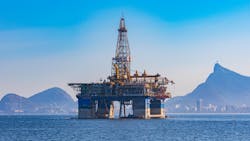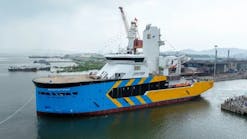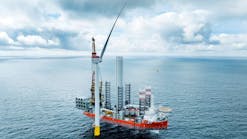Bruce Beaubouef * Managing Editor
Offshore operators are revving up their drilling campaigns in response to increased demand, higher oil and gas prices, and supply disruptions resulting from the conflict in eastern Europe.
With oil prices hitting eight-year highs, signs of recovery are popping up across the entire offshore drilling industry supply chain. Rig supply is tightening, dayrates are rising, and operators continue to make significant new discoveries and announce successful exploration drilling campaigns.
Earlier this year, new multi-year contracts were signed by Aker BP for Norway, APA for the UK North Sea, and Chevron for Thailand; and NOCs such as Petrobras, Saudi Aramco, QatarEnergy and ONGC have all signed new contracts for drilling services.
With increased demand, operators are offering higher day rates and longer contract terms for drilling rig contractors. In one of its recent notes, oilfield analyst firm Evercore ISI said: “We believe [that] lengthening contract terms are signs of a tightening offshore rig market, with the diverse customer and geographic mix highlighting a broad offshore recovery has commenced,” the firm said. Valaris and Maersk were the “clear winners,” Evercore said, booking 10 and 9 rig years in net backlog additions since mid-December, from Saudi Aramco and Aker BP, respectively.
Dayrates remain largely private, but Maersk’s extended frame agreement with Aker BP has an estimated value of $1 billion for two harsh-environment, high-spec jackups over five years, which implies an average day rate of $275,000/day or about $40 million in annual EBITDA per rig.
TotalEnergies also exercised a priced option for the ultra-deepwater drillship Maersk Valiant for another well off Suriname at $205,000/day, while ConocoPhillips secured the 400-ft Icon Caren for three wells offshore Malaysia at $75,000/day. APA also renewed Diamond Offshore’s Ocean Patriot, a midwater harsh-environment semisubmersible, for two years offshore the UKNS for an undisclosed price.
Offshore operators and producers are now focusing on what Westwood Global Energy Group describes as “high-impact exploration wells,” meaning wells that might not access bigger reserves, but will deliver quicker results. Seventy-four of these “high-impact exploration wells” were completed worldwide last year, according to Westwood.
Only 15 frontier exploration wells were completed last year, the lowest since 2008, and only one delivered even a modest commercial discovery, Westwood says. The dip in frontier exploration drilling suggests the industry is less concerned with long-term renewal of resources and is instead focusing on quicker returns. The most active “high-impact explorers,” according to Westwood, were ExxonMobil (13 wells), TotalEnergies, Petronas, and Shell (nine each).
This year’s drilling plans suggests the pattern will continue with 70-80 high impact wells expected to be completed during 2022. Locations to watch will be South America’s Suriname-Guyana basin, offshore Brazil, the US and Mexican sectors of the Gulf of Mexico, and the Flemish Pass off Eastern Canada.
Other frontier tests are planned in Africa’s Orange, Rio Muni, Mozambique, and Lamu basins.
In Northwest Europe, ~10 high-impact wells should be drilled, while a largest prospect is due to be drilled in the Iranian Caspian Sea.
The most significant discovery to be announced so far this year is TotalEnergies’ Venus discovery off Namibia. Reports have indicated that Venus could prove to be the largest deepwater find the world has seen to date with potentially over 13 billion boe. It is understood TotalEnergies is planning appraisal drilling later this year which will provide more certainty. Some analysts speculate that Namibia could soon see the same levels of drilling activity currently seen offshore Guyana.
Namibia has seen not one but two game-changing discoveries this year. Shortly before the Venus discovery was announced Shell was confirmed to have made a discovery at Graff with reports indicating that it could hold around 2 billion barrels of oil and up to 6 trillion cubic feet of gas. Further exploration drilling activities were undertaken immediately after the Graff well with drilling to resume under the current year-long charter of Maersk Voyager.
Guyana continues to see positive well results with no less than five new discoveries announced so far this year including Fangtooth, Lau Lau, Barreleye, Lukanani and Patwa for ExxonMobil. There are currently six drillships working for ExxonMobil offshore Guyana with firm charters stretching into late 2025 for the four Noble rigs and options for two Stena units stretching up to 2024. ExxonMobil is said to be looking to drill 12 further exploration and appraisal wells at the Canje and Kaieteur blocks offshore Guyana. It is yet to be seen whether these additional plans, on top of ongoing development drilling, will see additional rig capacity added to the fleet but it is a possibility, says consulting firm Esgian.
Neighboring Suriname continues to garner attention with TotalEnergies and APA Corporation announcing a discovery at Krabdagu in Block 58 in February. Operator TotalEnergies confirmed at the time that the well encountered approximately 90m of net oil pay. At least three further exploration and appraisal wells are planned at Block 58 this year.
Meanwhile, offshore E&P continues to heat up offshore Brazil. In early May, Petrobras issued a tender to contract up to eight ultra-deepwater rigs for drilling operations offshore Brazil. Esgian reports that the tender is divided into three lots. Lot 1 is for up to two high-spec rigs with drilling capabilities in water depths up to 3,000m (~10,000ft). Lot 2 is for up to five high-spec rigs with drilling capabilities in water depths up to 2,400m (~8,000ft). Lot 3 is for one rig with drilling capabilities in water depths up to 2,400m (~8,000ft).
The exact contract start date is not specified, but lot 1 and lot 2 are expected to start between January and November 2023, while lot 3 is expected to start between December 2022 and September 2023. The contract durations are also substantial. Lot 1 has the longest contract duration with a firm period of four years, while lot 2 and lot 3 have a firm period of three years. All of the contracts will be extendable for a period equal to the firm period.
Esgian says that there are currently thirty-two floaters operating in South America capable of drilling at >8,000ft (with more drillships mobilizing this year), most of which are on long-term contracts and will not be available for this tender.
There are thirteen floaters that will potentially be available before November 2023, however, some of these units are expected to have their contracts extended further. With the current demand and supply in the region, additional floaters will have to be sourced from other regions.
Drilling off Southeast Asia is also expected to rebound this year. A report from Wood Mackenzie said that wells to watch in this region include Harbor Energy’s Timpan-1 and Repsol’s Rencong-1, both targeting deepwater gas off northern Sumatra; TotalEnergies deepwater Tepat North-1 well offshore Sabah; Eni’s program in Vietnam’s Song Hong basin; and Western Gas’ potentially giant Sasanof-1 gas prospect offshore Western Australia’s North West Shelf.
Meanwhile, Norway continues to be the leader in offshore drilling and production. Aker BP and Equinor are understood to be planning to drill a total of 13 and 25 wells, respectively, over the course of the year with other operators of course adding to the overall tally. Already some significant discoveries have been announced in Norwegian waters. Most recent discoveries include Equinor’s Kveikje (temporary name) which contains preliminary estimates of between 25 and 50 million barrels of recoverable oil equivalent, and Neptune Energy’s Hamlet, which contains preliminary estimates of 30 to 50 barrels of oil equivalents. Overall, the Norwegian Petroleum Directorate anticipates 30-40 exploration wells across the Norwegian outer continental shelf this year.
Jackup demand
Jackup demand and utilization is growing at such a rapid clip that capacity is being strained in some regions. As of mid-April, there have been 20 term jackup contracts announced year to date, with 14 in the Middle East, four in the North Sea, and two in Asia. The marketed utilization for jackups increased by 137 basis points over the month of March, driven by a pickup in the North Sea and Mexico.
Evercore also noted that including a 5% decline in supply, the North Sea’s jackup utilization is up 1,100 basis points over the past year, while the working rig count is 12% higher than a year ago. In fact, the North Sea could soon be short of jackups, says Evercore. Per Petrodata RigBase, 29 of 38 jackups in the North Sea are under contract. However, excluding a cold-stacked jackup that is not marketed, only three of eight warm-stacked jackups are available (Maersk Highlander, Noble Sam Hartley, Well-Safe Protector), since the remaining five units have contracts starting over the next six months.
This includes two units heading to the Middle East, with the Noble Houston Colbert heading there for a 3.5-year contract with Qatargas and Aurora JSC’s Perro Negro 8 for a five-year contract with Saudi Aramco. Borr Drilling’s jackup Ran will also depart the UK for a new 5.5-month contract with Wintershall DEA offshore Mexico. With the imminent departure of three jackups, the North Sea’s jackup supply will fall to 35 units, the lowest since 2009. The jackup supply in the UK will also fall to 14 units, with Valaris retaining a leading market share.
It is this possible shortage of jackups that has led the UK Competition and Markets Authority to hold up the proposed merger of Noble Corp. and Maersk Drilling. In April, the UKCMA saisd that the proposed merger “gives rise to a realistic prospect of a substantial lessening of competition in relation to the supply of jackup rigs in North West Europe (excluding Norway),” and that a remedy to address such effect would be required to avoid a reference to a Phase 2 review. The companies say they will seek to reach an agreement with a potential purchaser regarding the sale of the designated “remedy rigs” under their “remedy proposal.”
Floating rig demand
Demand for floating rigs is also growing at a rapid clip, with floaters making up 86% of the awards this past February, according to Evercore. While no contract awarded was for more than four months, the firm commented that “day rates are clearly trending higher with Transocean signing a new contract for the Deepwater Asgard at a substantially higher rate.”
The Deepwater Asgard, a seventh-generation drillship, was awarded a two-well contract from an undisclosed operator in the US Gulf of Mexico at $395,000/day, up from its current $295,000/ day charter with Hess. Evercore said that the rate likely includes managed pressure drilling services, with Transocean previously disclosing that the $295,000/day average on the Deepwater Asgard’s one-well contract with Hess received an incremental $40,000/day for MPD services.
While MPD is generally required for HP/HT reservoirs such as Petrobras’ presalt regions and the Gulf of Mexico’s Lower Tertiary areas, it is also used to enhance drilling performance.
About 30 floaters and three jackups are fully equipped with MPD currently, with NOV recently upgrading the Noble Gerry de Souza with MPD and a second BOP for its one-well plus two option well contract offshore Suriname for APA.






